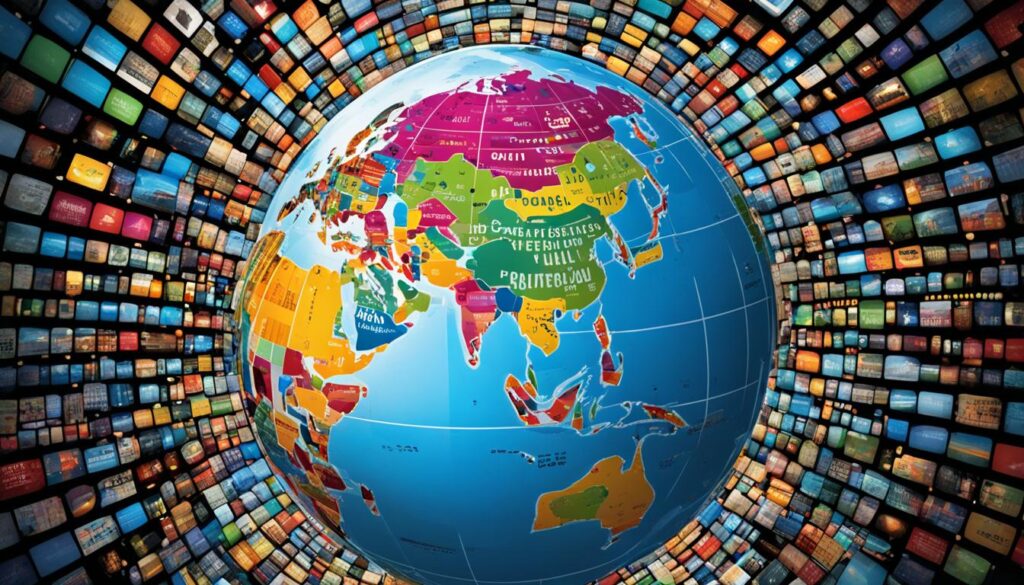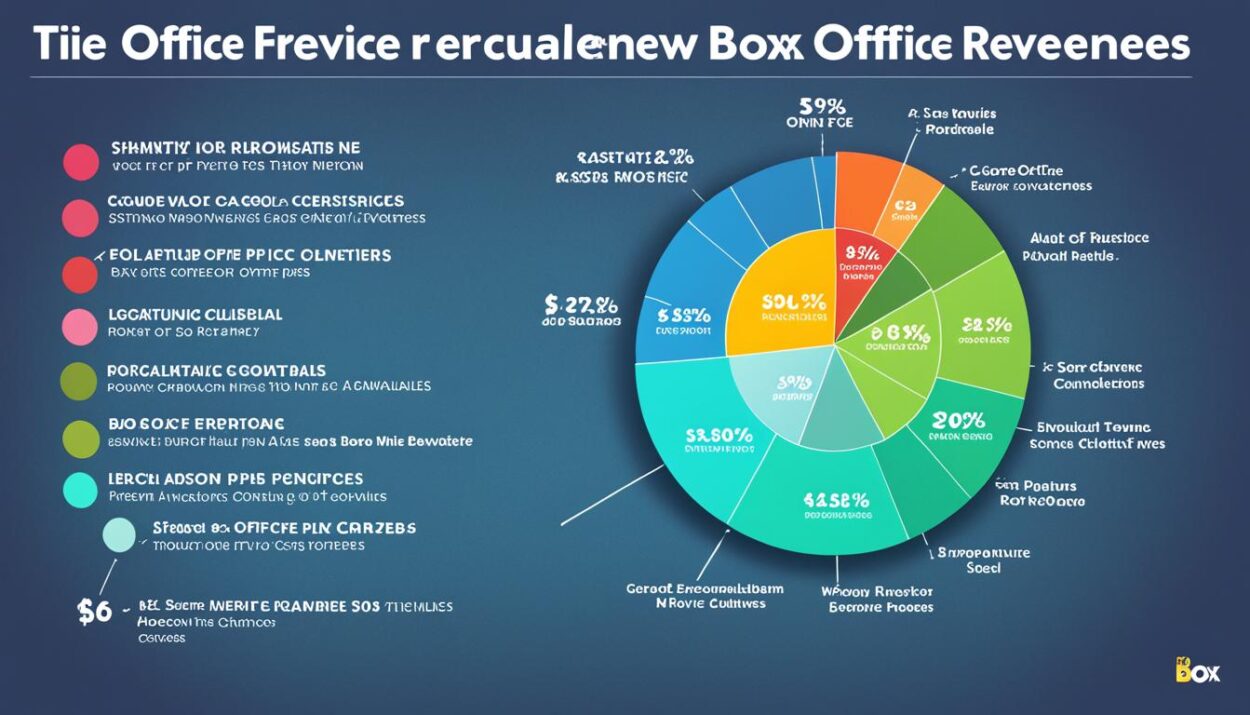The movie industry is a vast world of stories told through film, shaped by new technology, different cultures, and trends in cinema. It is expected to grow to $344.84 billion by 20271. It includes everything from big Hollywood hits to small indie movies. People around the world love it for the feelings, connections, and fun it brings.
Cultural and regional differences greatly impact the film industry. For example, China, now the second biggest movie market, made 1,082 movies in 2018. This was a huge jump from 526 in 20101. The money made from movies in Asia could go up to $43.14 billion by 2029. By then, it’s expected that 1.1 billion people will be watching1. This shows how important local markets are becoming in the movie world.
Key Takeaways
- The global film and video market is set to reach $344.84 billion by 20271.
- China’s film market is rapidly growing, with over 1,000 movies produced annually1.
- The Asian cinema market is projected to reach $43.14 billion by 20291.
- Hollywood blockbusters and independent films cater to a wide, global audience.
- Technological and cultural influences play a crucial role in shaping the movie industry.
Understanding the Impact of COVID-19 on the Movie Industry
The COVID-19 pandemic changed the movie industry a lot. It moved the focus to home entertainment and digital platforms. Because of lockdowns, making movies stopped and many releases were delayed. This article looks at these big changes.
Changes in Theatrical Releases
The pandemic made global theatrical revenue fall from $42.3 billion in 2019 to $12 billion in 20202. Lockdowns and having to stay apart led to this huge decrease. In 2020, box office money was the lowest in 40 years, only getting to $2.2 billion in the U.S.2. The number of movies coming out in theaters fell by 66%, with only 338 movies released2.
On the other hand, digital movies made a lot more money. Digital entertainment revenue went up by 31% in 2020, reaching $61.8 billion2. This big move to digital shows how COVID-19 changed how we watch movies. Still, the global revenue from both theaters and home/mobile entertainment went down by 18% to $80.8 billion in 20202.
Rise of Streaming Services
Streaming services, like Netflix, got a lot more users. Netflix had nine of the ten most-watched original TV shows in 2020. Online video money went up by 35%2. The number of online video users worldwide went up to 1.1 billion, a 26% increase from 20192.
In the U.S., OTT service users increased by over 50% in 20203. By 2021, home entertainment was 79% of the nearly $100 billion global video industry3. Digital entertainment made three times more money than box offices by 20203. Around 2 billion people use OTT platforms globally, with a 40.9% user rate3.
The rise of digital movies is clear in how many people subscribe and who they are. Younger people, like Millennials and Gen Z, prefer watching on smart devices than traditional TV or cinema3. China also saw a big increase in OTT users since COVID-19 started, showing a global change3.
Movie studios started releasing movies directly to consumers as a way to make money. This move to home and digital platforms means studios need to think differently about how to release movies. Some movies, like “Godzilla vs. Kong,” came out both on streaming services and in theaters. It made over $350 million globally in just two weekends on HBO Max in 20212.
The COVID-19 pandemic has quickly changed the movie industry. Now, both movie watchers and makers are getting used to new ways of distributing and watching content.
Box Office Revenue Trends Over the Years
Looking at box office trends shows how movie revenues have changed. This change affects how much money studios make and how much people spend on movies. We see important events in history that changed how the movie industry works.
Historical Box Office Data
In 1977, “Star Wars: Episode IV – A New Hope” made a big splash. It boosted revenue by 290.6% compared to the year before4. After that, we saw more growth. From 1979 to 1980, revenue jumped by 33.6%4. The year 1997 had an 8.5% increase from 1996. Then, 1998 went up by 10.2%4. The year 2000 also saw a rise, with a 1.8% increase from 19994.
Through the years, box office trends kept changing. In 2009, there was a significant 10% growth. This brought in a total of $10,615,886,2834. These trends show that people keep spending more on movies.
Recent Box Office Performance
Recent years have had a big impact on box office results. In 2019, the industry hit its recent high, making $13,208,773,8925. This shows that theaters are still key for making money, despite new ways to watch movies.
The pandemic was tough, but 2021 was a strong year. Thanks to hits like “Spider-Man: No Way Home,” revenue soared by 112.1%4. In 2023, we saw a 20.9% rise from the year before, hitting $8,908,261,4734. The year 2024 also did well. It made a total of $6,863,873,446 with an average ticket price of $10.785.
Having exclusive times to show movies has always helped make more money. The jump in ticket prices, from $4.35 in 1995 to $10.78 in 2024, shows how spending on movies changes5.
Average Movie Budgets and Production Costs
The movie industry sees costs going up. Things like high actor fees, cool visual effects, and new tech are to blame.
Breakdown of Budget Categories
Films have different budget areas, each very important. We have:
- Pre-production: This includes script writing, finding actors, and picking locations.
- Production: This is about building sets, paying the crew, and renting equipment.
- Post-production: This part includes editing, adding visual effects, and working on sound.
- Marketing: Money goes here for ads like trailers, billboards, and online promotions.
On average, a big movie costs about $100 million to make and market6. From start to finish, every stage needs big money for a film to do well.
Influences on Rising Production Costs
Several things make movie making more expensive:
- Technology: Better visuals and CGI push costs up. “Avatar” cost $237 million because of its high-tech effects6.
- Talent Fees: Famous actors and directors make a film costlier. Before COVID-19, Hollywood was worth $504 billion7.
- Marketing: Big films spend a lot on ads. “Spiderman 2” spent $75 million on marketing, besides $200 million on making it6.
- Pandemic: COVID-19 made things like wood pricier, adding to costs8.
In 2019, movies made a huge $42.5 billion worldwide, even with high costs6. But the total cost of making and marketing a film is around $100 million8. For context, “Pirates of the Caribbean: On Stranger Tides” was the priciest at $378.5 million6.
Understanding money in movies helps studios deal with rising costs. Learning from successful budgets and knowing what drives costs up can keep the movie world strong and competitive.
Audience Demographics: Who’s Watching What?
Understanding who watches what is key for movie studios. They look at age and gender to figure out their audience. Knowing this helps them direct their marketing efforts better to people who love movies.
Age Groups and Movie Preferences
People aged 18-34 enjoy going to the movies quite a bit, with half of them saying they go often9. Those between 35-44 also like going, but a little less, showing 45% go frequently9. The 25-39 year-olds are the biggest movie fans, making up 24% of the audience in 201710. This information helps movie marketers focus on what different age groups prefer.
Gender Trends in Movie Viewership
When it comes to gender, movie watching habits tell more of the story. Nearly half of the male adults in the U.S. enjoy movies a lot9. Meanwhile, women are almost as likely to buy movie tickets as men, with sales almost even in 201710. This shows that movies need to appeal to both men and women equally.
How much money people make also affects how often they go to the movies. Those earning under $50,000 a year visit theaters less often than those who earn above $100,0009. This highlights the need for marketers to think about income when targeting moviegoers.
Looking at race, white audiences bought 55% of movie tickets in 2017, which is a lot9. Hispanic, black, and Asian audiences also contribute significantly to movie ticket sales9. Hispanics, interestingly, buy more tickets than their share in the population might suggest10.
Younger people are tuning into streaming services, which changes their movie habits9. This trend is shaking up the usual audience profiles, bringing in viewers of all ages9. So, understanding these changes is crucial for movie marketers today.
Streaming Viewership: A New Era in Entertainment
Streaming platforms have changed how we watch shows and movies. They’re more convenient than traditional TV like cable. This marks a big shift in how entertainment works.
Popular Streaming Platforms
There are a lot of streaming services now. By 2023, people in the U.S. could choose from 90 services. That’s up from 51 in 202011. Netflix is making more shows and movies of its own. They plan to make 60% of their shows and movies by July 2023. They aim for 75% by December 2024, and 100% by May 202712.
In 2023, some shows and movies were really popular. For example, “Suits” was top on Nielsen’s list for 12 weeks. It got 57.7 billion minutes watched. “Moana” on Disney+ was also popular, with 11.6 billion minutes watched11.
Impact on Traditional Media
More people are streaming, and it’s affecting traditional media. In 2023, people streamed videos for 21 million years in total. That’s 21% more than the year before11. Streaming services mainly make money from subscriptions. This gives people lots of content for a monthly fee13.
This is different from how movies at the cinema make money. And it brings new challenges for showing how much money is made13. By February 2023, streaming was more than one-third of all TV watched. It stayed above 35% until May. This shows that cutting cable is a strong trend11.
International Markets: Global Influence on the Movie Industry
International markets greatly affect Hollywood and its earnings. They also shape our views through movies. The global entertainment market was valued at USD 100.38 billion in 202314. It’s expected to grow annually by 8.1% until 2030. Making movies that connect with people worldwide is now key. This includes showing movies on new screens, like the 2,000 added in China14.
Top Performing International Markets
The Asia Pacific region’s movie market is booming. It might grow by 9.2% each year soon14. In 2021, North America led the global scene with a 34.5% share15. These numbers highlight how crucial international viewers are for movie makers.
| Region | CAGR (2024-2030) | Market Share (2021) |
|---|---|---|
| North America | 7.2% | 34.5% |
| Asia Pacific | 9.2% | 8.2% |

Localized Storytelling and Its Impact
Adapting stories for different cultures has become a winning approach. It makes movies more relatable worldwide. This embrace of local tales has grown with streaming giants like Netflix and Amazon Prime Video15. Warner Music’s deal in India, covering 23 languages and over 30,000 songs, shows the power of cultural connection14.
The global movie scene is growing fast. And the international box office’s role in this growth is becoming more vital. Films that reflect local cultures will likely win fans all over the planet.
Exploring Genre Trends Over the Decades
The landscape of popular movie genres has seen remarkable shifts, reflecting broader cinema trends and evolving audience genre preferences. Through the combination of qualitative and comparative analysis approaches, historical performance data for genres like action, adventure, horror, comedy, and drama offer valuable insights into their box office success and audience reception16. For instance, action and adventure movies continue to dominate audience demand, holding the majority of top film positions in 202317.
Historical evolution and comparative analysis of major film genres reveal distinct characteristics and cultural influences shaping Hollywood and Bollywood16. Furthermore, adventure and action films, known for their broad appeal, reinforce the franchise model’s success, while horror films rise as cost-effective productions17. These findings can be attributed to thorough reviews of literature, scholarly articles, and reputable sources, which highlight the unique approaches and conventions within these industries16.
Data also shows that the consistency in audience demand across genres like adventure, action, horror, comedy, and drama underscores how deeply these themes influence viewers’ choices throughout the year17. Additionally, television series performances reflect that drama genres lead in demand, yet shows with spectacle-oriented elements are gaining traction, hinting at a potential shift in audience preferences17.
By analyzing genre-specific box office data, trends become apparent, showcasing the role of globalization and cultural narratives in shaping audience tastes16. Notably, the rise in genre-specific demands aligns with releases that resonate well with contemporary themes and storytelling techniques, such as apocalyptic series like HBO’s “The Last of Us”17. This trend suggests an intertwined relationship between content relevance and viewer engagement, driven by genre evolution.
| Year | Top Genre | Audiences |
|---|---|---|
| 2023 | Action | Broad, franchise-oriented |
| 2022 | Adventure | Broad |
| 2021 | Horror | Specific, cost-effective production |
| 2020 | Drama | Long-form storytelling |
Ultimately, audience genre preference and cinema trends evolve in response to cultural shifts, technological advancements, and innovative storytelling, making the analysis of these elements crucial for predicting future developments in the film industry1617.
How Awards and Recognition Influence Movie Success
Prestigious film awards have a big effect on a movie’s success. They can increase box office revenue and critical praise. Films with major awards see more interest and ticket sales. This shows the financial perks of winning movie awards.
Impact of Major Awards on Box Office
Winning prestigious film awards often boosts a movie’s box office earnings. For example, an Oscar win can transform a film from doing okay to a huge hit. It draws a wider audience. In the last decade, movies have made over $107 billion thanks to awards and critical acclaim18. Moreover, getting positive reviews during awards season can help a movie get nominations and wins. This can further increase its earnings19.
Trends in Award-Winning Genres
Some genres do better in awards season than others. Dramas, especially those with historical or social messages, get more nominations and wins. This is more common than in genres like action or science fiction18. Dramas and historical epics are the most recognized genres at the Oscars. This shows how genre affects a film’s success.
Also, good movie reviews are important during awards season. They can change how people see the movie and help it make money long after it leaves theaters. Through digital downloads, streaming, and home sales19. Good reviews and audience love can keep a film profitable. This highlights the big impact awards and recognition have on films.
Effective Movie Marketing Strategies
Movie marketing plays a key role in a film’s success. It uses various tactics and channels to grab the audience’s attention. Today, digital ads offer cost-effective ways to reach specific groups of people.
Traditional vs. Digital Marketing
Traditional marketing like TV and print ads reaches many but costs a lot20. On the other hand, digital ads are cheaper and target specific groups more precisely20. Independent filmmakers find social media and influencer marketing especially useful. Going to film festivals also helps a lot20.
Take Funke Akindele’s use of social media, for example. Her huge following on Instagram and TikTok helped make “A Tribe Called Judah” a hit21. This shows how direct engagement on social platforms can build excitement for new movies.
Case Studies of Successful Campaigns
The Barbie movie is a great example. It got people involved by letting them create personalized posters21. The movie also teamed up with brands like Airbnb and Burger King for more exposure21. Keeping up interest with exclusive clips and interviews on social media was another smart move21.
“Barbie” and “A Tribe Called Judah” both told stories people could connect with21. “Barbie” touched on gender issues and self-esteem, while “A Tribe Called Judah” depicted life in Nigeria21. Their success shows how important it is to include clever marketing from the start, not just after the film is made21.
The Role of PVoD in Modern Movie Financing
Premium Video on Demand (PVoD) has changed how movies make money. Studios now have new ways to make profits from streaming. With PVoD, studios get a bigger cut of the earnings than with old-fashioned theater releases. This new method offers them different ways to earn from their films.
Revenue Comparisons: PVoD vs. Theatrical Releases
Trolls World Tour by Universal showed how well PVoD works. In just three weeks of being online, it made more money than its earlier movie did in five months in theaters. It was available for $19.99 to rent for two days22. Warner Brothers saw similar success with Scoob! by releasing it on VoD. This proved that streaming can be more profitable than releasing movies in theaters22.
Consumer Response to PVoD
During the COVID-19 pandemic, 22% of US customers paid for a new movie on PVoD22. Around 24% of Gen X and 36% of Millennials bought movies this way. A noteworthy 51% of Millennials with kids rented at least one PVoD movie. This number rose to 56% for those with a streaming service subscription22.
Almost half of the US streaming subscribers chose services for exclusive content22. This shows how buying habits are moving towards on-demand viewing.
Interestingly, over 60% of Gen Z and Millennials plan to go back to theaters in the next six months22. This suggests a mix of PVoD success and traditional movie-going. It points to changing ways of making money from movies, helped by flexible strategies and consumers willing to adapt.
The Decline in Average Movie Ticket Sales
Movie ticket sales have dipped sharply, affecting cinema visits. This change poses challenges for the film industry. With more people choosing home entertainment, traditional cinemas are struggling.
Factors Contributing to Fewer Ticket Purchases
Streaming services are making it easy to watch movies at home, hurting cinema attendance. In 2023, the U.S. sold only 852 million movie tickets. This is a big drop from 2002’s 1.85 billion and 2019’s 1.23 billion tickets23. Also, high prices, like AMC’s $18.49 adult ticket in San Francisco23, are turning people away.
Implications for the Future of Theaters
Declining sales deeply impact theaters. In 2023, box office earnings were $5.3 billion, equal to earnings in 200523. This shows how cinemas are financially struggling. As habits change, theaters must adapt. The film industry needs creative ways to draw and keep audiences. They must balance traditional movie-going with new expectations.
The Importance of Theatrical Releases for Studios
Theatrical releases are crucial for film studios. They make up a large part of their income. Almost half of a studio’s money comes from these releases. This shows how important they are for making money24. Having a movie do well in theaters helps with making money in other ways later.

Revenue Sharing Models
Studios and theaters split the money made from ticket sales. Usually, studios get about 45% of the money from tickets24. But, during the pandemic, some studios made more money by selling movies directly to people’s homes. This way, they could keep almost 80% of the money24. It shows that studios need to be flexible to make money.
Expected Trends Post-Pandemic
After the pandemic, how movies are shared might change. Since the pandemic started, only 18% of people in the US have gone to see a movie in a theater24. Studios are thinking about using both theaters and online to release movies. A new deal lets them show movies online just 17 days after they start in theaters24. This could help them make more money while giving people what they want.
The way movies are released is changing. But, showing movies in theaters is still very important. It helps studios make money in different ways24.
Explore more about evolving revenue strategies and their impact on studios
How Technology is Shaping Modern Filmmaking
Technology is changing the way we make and watch movies. It brings new ways to tell stories and make them real for us. Now we can see things in movies that were impossible before, thanks to virtual reality and awesome visual effects. The film world is changing fast.
Advancements in Visual Effects
Modern filmmakers have some cool tools that change how movies are made. Cameras like the RED and ARRI Alexa capture stunning pictures25. Plus, Pro Tools make movie sounds crisp and clear25. Even editing software like Adobe Premiere Pro lets more people make movies that look professional25. These tech breakthroughs are making movies better and easier to create.
The Role of Virtual Reality
Virtual Reality (VR) and Augmented Reality (AR) are making movies more engaging25. In VR films, you’re not just watching; you’re a part of the story. This new way of making movies is exciting for both filmmakers and movie-goers. Also, tech allows for making movies remotely, which saves a lot of money25.
Colleges like Falmouth University are teaching students how to use these new tools, like DaVinci Resolve and ChatGPT25. Their Film & Television MA (Online) course is preparing students for the future. They learn about making great content and getting it to audiences. To see more about how tech changes movies, check out this article on technological impacts.
FAQ
What are some key film industry insights?
How has COVID-19 impacted theatrical releases?
What has been the rise of streaming services during the pandemic?
What do historical box office data reveal about movie industry trends?
How are recent box office performances shaping the industry?
How are movie budgets typically broken down?
What factors contribute to rising film production costs?
How do audience demographics influence movie preferences?
What are the current trends in gender-specific movie viewership?
Which streaming platforms are currently popular?
How has the rise of streaming impacted traditional media?
Which international markets have a significant influence on the movie industry?
How does localized storytelling impact global film success?
How have genre trends evolved over the decades?
What is the impact of major awards on a film’s box office success?
What genre trends are common in award-winning films?
How do traditional and digital marketing strategies compare in effectiveness?
Can you provide examples of successful movie marketing campaigns?
How does Premium Video on Demand (PVoD) compare to theatrical releases in terms of revenue?
What has been the consumer response to PVoD?
What are the factors contributing to the decline in average movie ticket sales?
What are the implications for theaters due to declining ticket sales?
Why are theatrical releases important for studios?
What trends are expected post-pandemic for theatrical releases?
How are technological advancements shaping modern filmmaking?
What are the latest breakthroughs in visual effects technology?
How is virtual reality influencing the film industry?
Source Links
- https://passivesecrets.com/film-industry-statistics/
- https://www.forbes.com/sites/bradadgate/2021/04/13/the-impact-covid-19-had-on-the-entertainment-industry-in-2020/
- https://www.ncbi.nlm.nih.gov/pmc/articles/PMC9816632/
- https://www.boxofficemojo.com/year/
- https://www.the-numbers.com/market/
- https://www.investopedia.com/financial-edge/0611/why-movies-cost-so-much-to-make.aspx
- https://scottmax.com/film-industry-statistics-to-know/
- https://www.studiobinder.com/blog/average-movie-budget/
- https://www.gruvi.tv/post/movie-audience-demographics/
- https://www.movieguide.org/news-articles/who-goes-to-the-movies-4.html
- https://www.nielsen.com/insights/2024/streaming-unwrapped-streaming-viewership-goes-to-the-library-in-2023/
- https://blog.filmtrack.com/industry-insights/streaming-platforms-and-their-impact-on-the-film-industry
- https://motionpicture.edu/socialcinema/2023/06/19/the-impact-of-streaming-services-on-the-movie-industry/
- https://www.grandviewresearch.com/industry-analysis/movies-entertainment-market
- https://www.skyquestt.com/report/movies-and-entertainment-market
- https://www.paradigmpress.org/as/article/download/736/628
- https://www.parrotanalytics.com/insights/genre-trend-analysis-of-2023-film-and-television/
- https://ucladatares.medium.com/the-success-of-movies-at-the-oscars-box-office-and-reviews-e33e5059ea40
- https://medium.com/@shannelreviews/the-impact-of-film-reviews-on-box-office-success-e281dbcffbb1
- https://www.gruvi.tv/post/film-marketing-strategies/
- https://www.linkedin.com/pulse/how-film-marketing-impacts-success-top-movies-2023-funmi-onuma-zeabe
- https://www2.deloitte.com/us/en/insights/industry/technology/pvod-upend-content-covid.html
- https://wolfstreet.com/2024/01/22/us-movie-ticket-sales-45-in-2023-from-21-years-ago-amc-and-the-movie-theater-meltdown/
- https://www2.deloitte.com/us/en/insights/industry/technology/future-of-the-movie-industry.html
- https://www.falmouth.ac.uk/news/how-technology-has-changed-film-industry





